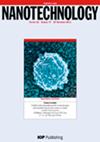MXene单层膜挠性电的从头算研究。
IF 2.8
4区 材料科学
Q3 MATERIALS SCIENCE, MULTIDISCIPLINARY
引用次数: 0
摘要
我们从第一性原理研究了MXene单层膜中的挠性电。具体来说,我们利用Kohn-Sham密度泛函理论计算了126个MXene单层膜沿两个主方向的横向挠曲电系数。这些值从0.19e到1.3e的范围很广,在弯曲方向上几乎是各向同性的。研究发现,过渡金属在挠曲电响应中起着重要作用,氮基MXenes始终显示出比碳化物更大的系数。此外,这些系数随着结构厚度的增加而增加,但当用弯曲模量归一化时,它们呈现相反的趋势,弯曲模量也计算了所有126层。本文章由计算机程序翻译,如有差异,请以英文原文为准。
Ab initiostudy of flexoelectricity in MXene monolayers.
We investigate flexoelectricity in MXene monolayers from first principles. Specifically, we compute the transverse flexoelectric coefficients of 126 MXene monolayers along their two principal directions using Kohn-Sham density functional theory. The values span a wide range from 0.19 eto 1.3 eand are nearly isotropic with respect to bending direction. The transition metal is found to play a significant role in the flexoelectric response, with nitride-based MXenes consistently displaying larger coefficients than their carbide counterparts. Moreover, the coefficients increase with structural thickness, but when normalized by the bending modulus, which is also computed for all 126 monolayers, they exhibit the opposite trend.
求助全文
通过发布文献求助,成功后即可免费获取论文全文。
去求助
来源期刊

Nanotechnology
工程技术-材料科学:综合
CiteScore
7.10
自引率
5.70%
发文量
820
审稿时长
2.5 months
期刊介绍:
The journal aims to publish papers at the forefront of nanoscale science and technology and especially those of an interdisciplinary nature. Here, nanotechnology is taken to include the ability to individually address, control, and modify structures, materials and devices with nanometre precision, and the synthesis of such structures into systems of micro- and macroscopic dimensions such as MEMS based devices. It encompasses the understanding of the fundamental physics, chemistry, biology and technology of nanometre-scale objects and how such objects can be used in the areas of computation, sensors, nanostructured materials and nano-biotechnology.
 求助内容:
求助内容: 应助结果提醒方式:
应助结果提醒方式:


